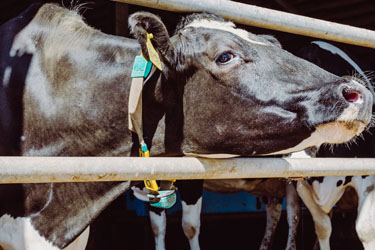Veterinarian Tips: Farm Biosecurity

Guarding a farm and its stock against the spread of disease takes more than shots and work to maintain a clean environment. It requires a biosecurity plan.
Biosecurity
In agriculture, keeping disease out of a herd or flock is vital to the future of a farm. Clients need to keep in mind that it only takes the germ of one infected animal to spread disease to all. Biosecurity offers a system of established management practices that will help stop infectious agents from spreading onto farm ground.
Pass the following information on to your clients to ensure their farms remain safe from disease.
Determine a Plan
Forming biosecurity measures that protect a farm against the introduction of disease isn’t difficult, but it does take planning. To prevent infectious agents from entering onto farm property, the following steps need to be determined:
Screening
Develop procedures to screen every incoming animal for signs of illness. Information must cover procedures to:
Quarantine
First, identify what a new arrival is. Is a newly purchased animal a new arrival or is an animal moved from one area to another on the farm considered a new arrival?
New arrivals must be provided a separate area that isolates them from the other animals until the holding period is complete. Identify the following information:
- Location—Establish a quarantine area that will keep the animal isolated and be easy to decontaminate if the animal is sick or after containment.
- Time—Determine the minimum length of time the animal will spend in quarantine and establish a way to clearly track this information.
Employee Responsibilities
Determine and outline procedures for employees to follow. Focus on employee movement to, within, and out of the quarantine area.
Identify work responsibilities for maintaining a quarantined area that eliminates the chance to spread infectious agents. Educate and train employees
Monitoring Methods
- Develop a monitoring program that allows for the input of information.
- Identify actions and activities that should be monitored.
- Determine quick, but accurate, methods that can be used to evaluate the animals.
- Outline responsibilities of staff for obtaining and inputting information.
Biocontainment
Preventing the spread of disease involves building a plan that identifies how to contain the disease. Consideration needs to be given to:
- Developing a plan to prevent the spread of infectious agents between animals in quarantine areas or between animals in different areas of the farm, as well as preventing infections agents from being carried from one farm location to another or from the farm to the outside world.
- Steps that identify biocontainment procedures that staff must be ready to follow if an infectious agent is discovered.
Risk
Identifying risk levels based upon disease characteristics will help to establish a biosecurity plan. The focus needs to look at specific areas and the activities that go on within these areas. The higher the risk, the more susceptible to the entry of disease, which could potentially increase the spread of disease between animals, areas within the farm, and to other farms.
In general, areas should be classified based on disease prevalence:
- Low risk, such as a farm office
- Moderate risk, such as a tack room
- High risk, such as a quarantine area
A biosecurity plan should also classify areas of risk according to modes of distribution or level of severity. This can be done by evaluating the way diseases enter and spread within a farm and identifying how disease affects farm products. Farm products may include:
- Meat
- Milk
- Breeding stock
- Embryos
Get All Involved
For a biosecurity plan to work and remain effective, procedures need to be firmly followed. Every person who works, visits, and lives at the farm should understand their role in keeping infectious agents away from the property, its stock, and its products.
Note to Veterinarians
Ensure biosecurity measure are followed inside your practice by instituting these precautions for zoonotic disease transmission. Discover more about the importance of disinfectants in biosecurity in Animal Health Solutions.
Contact your Covetrus representative for additional information to help clients online or at 855.724.3461.
Sources:http://extension.psu.edu/animals/health/biosecurity/fundamentals/biosecurity-a-practical-approach
http://www.farmbiosecurity.com.au/about/
http://www.e-digitaleditions.com/i/740022-november-2016/7?m4=Careers
Are you looking for a place to let your talents shine? At Covetrus, we help our practitioner customers better serve their patients and take pride in providing the best customer experience possible. Search our open positions to see our available opportunities.
Newsletter
Stay current with what’s going on with Covetrus, subscribe to receive our newsletter and email communications. Subscribers will receive the latest information in practice management, sales and marketing, animal health, and more.


Leave a comment